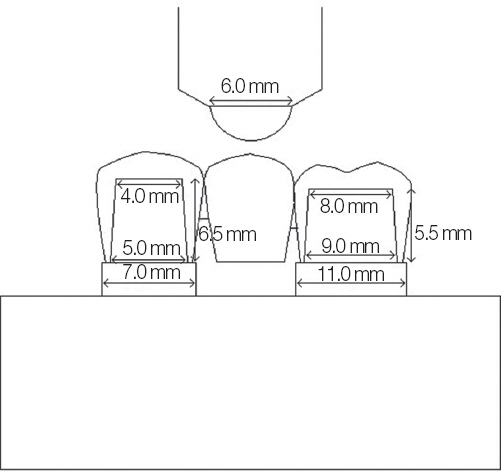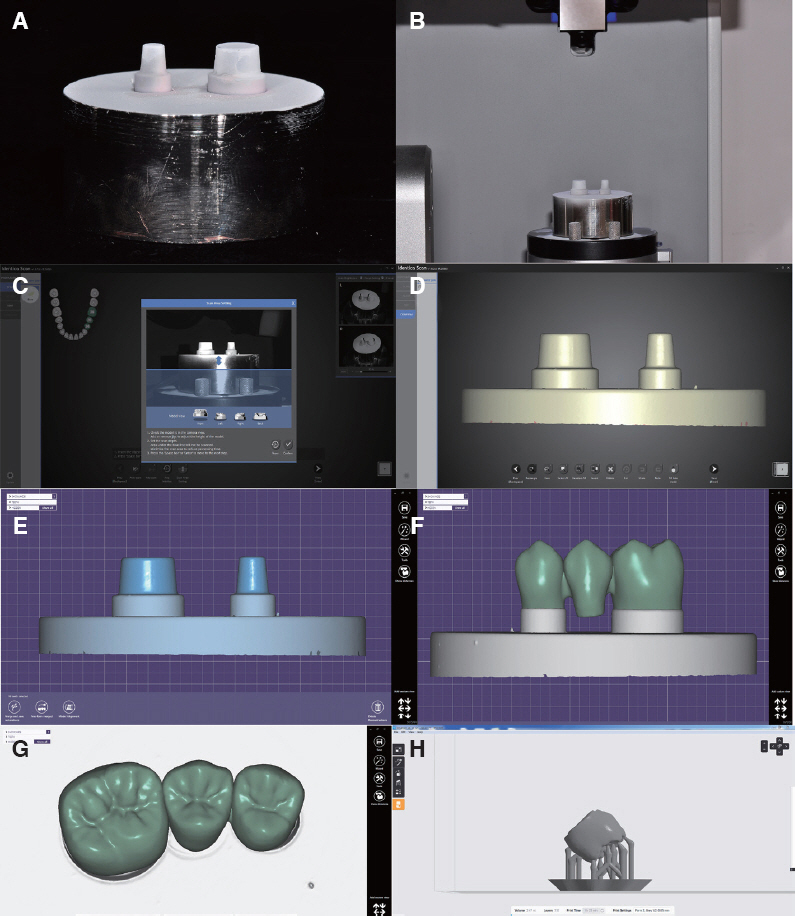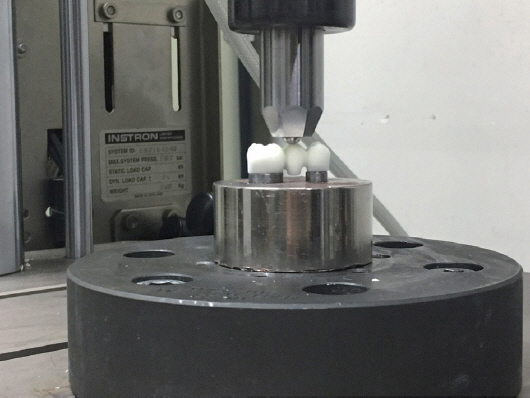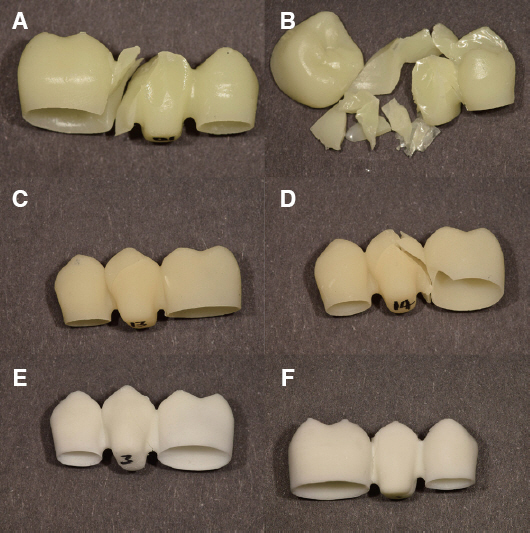J Dent Rehabil Appl Sci.
2017 Dec;33(4):260-268. 10.14368/jdras.2017.33.4.260.
Flexural strength of various kinds of the resin bridges fabricated with 3D printing
- Affiliations
-
- 1Department of Prosthodontics & Dental Research Institute, Seoul National University, Seoul, Republic of Korea. ksy0617@snu.ac.kr
- 2Department of Prosthodontics, Yonsei University, Seoul, Republic of Korea.
- 3Aekyung Chemical Co., Seoul, Republic of Korea.
- KMID: 2405538
- DOI: http://doi.org/10.14368/jdras.2017.33.4.260
Abstract
- PURPOSE
Manufacturing with AM (Additive manufacturing) technique has many advantages; but, due to insufficient study in the area, it is not being widely used in the general clinic. In this study, differences of flexural strength among various materials of 3 unit fixed dental prosthesis were analyzed.
MATERIALS AND METHODS
A metal jig for specimens that had a 3-unit-fixed dental prosthesis figure were fabricated. The jigs were made appropriately to the specifications of the specimens. Three different kinds of materials of specimens which were NC (mathacrylic esther based), DP-1 (Bisphenol A epoxy acrylate type oligomer based), and DT-1 (urethane acrylate based) were printed with DLP machine. Five specimens for each kind of material were printed with an angle of 30° from the horizontal surface. The specimens were placed on the jig and the flexural strength was measured and recorded using Universal testing machine. The recorded data was analyzed in SPSS using One-way ANOVA and Tukey HSD to determine the significance of the differences of flexural strength among the groups.
RESULTS
The flexural strengths of each group were the followings: NC, 1119 ± 305 N; DP-1, 619 ± 150 N; DT-1, 413 ± 65 N. Using One-way ANOVA and Tukey Honestly Significant Difference test, significant difference was found between NC and the other groups (P < 0.05), but there was no significant difference between DP-1 and DT-1 (P > 0.05).
CONCLUSION
Higher flexural strength was shown in 3-unit-fixed dental prosthesis that were 3D printed using a DLP machine with NC material.
Keyword
Figure
Reference
-
References
1. Ishida Y, Miyasaka T. Dimensional accuracy of dental casting patterns created by 3D printers. Dent Mater J. 2016; 35:250–6. DOI: 10.4012/dmj.2015-278. PMID: 27041015.2. Kim DY, Jeon JH, Kim JH, Kim HY, Kim WC. Reproducibility of different arrangement of resin copings by dental microstereolithography: evaluating the marginal discrepancy of resin copings. J Prosthet Dent. 2017; 117:260–5. DOI: 10.1016/j.prosdent.2016.07.007. PMID: 27646792.3. Park JY, Jeong ID, Lee JJ, Bae SY, Kim JH, Kim WC. In vitro assessment of the marginal and internal fits of interim implant restorations fabricated with different methods. J Prosthet Dent. 2016; 116:536–42. DOI: 10.1016/j.prosdent.2016.03.012. PMID: 27174406.4. Gebhardt A, Schmidt FM, Hötter JS, Sokalla W, Sokalla P. Additive manufacturing by selective laser melting the realizer desktop machine and its application for the dental industry. Phys Procedia. 2010; 5:543–9. DOI: 10.1016/j.phpro.2010.08.082.5. Barazanchi A, Li KC, Al Amleh B, Lyons K, Waddell JN. Additive technology: update on current materials and applications in dentistry. J Prosthodont. 2017; 26:156–63. DOI: 10.1111/jopr.12510. PMID: 27662423.6. Tunchel S, Blay A, Kolerman R, Mijiritsky E, Shibli JA. 3D printing/additive manufacturing single titanium dental implants: a prospective multicenter study with 3 years of follow-up. Int J Dent. 2016; 2016:8590971. DOI: 10.1155/2016/8590971. PMID: 27313616. PMCID: PMC4903129.7. Cheng A, Humayun A, Cohen DJ, Boyan BD, Schwartz Z. Additively manufactured 3D porous Ti-6Al-4V constructs mimic trabecular bone structure and regulate osteoblast proliferation, differentiation and local factor production in a porosity and surface roughness dependent manner. Biofabrication. 2014; 6:045007. doi:10.1088/1758-5082/6/4/045007. DOI: 10.1088/1758-5082/6/4/045007.8. Carter SD, Costa PF, Vaquette C, Ivanovski S, Hutmacher DW, Malda J. Additive biomanufacturing: an advanced approach for periodontal tissue regeneration. Ann Biomed Eng. 2017; 45:12–22. DOI: 10.1007/s10439-016-1687-2. PMID: 27473707. PMCID: PMC5215138.9. Al Mortadi N, Jones Q, Eggbeer D, Lewis J, Williams RJ. Fabrication of a resin appliance with alloy components using digital technology without an analog impression. Am J Orthod Dentofacial Orthop. 2015; 148:862–7. DOI: 10.1016/j.ajodo.2015.06.014. PMID: 26522047.10. Chen J, Ahmad R, Suenaga H, Li W, Sasaki K, Swain M, Li Q. Shape optimization for additive manufacturing of removable partial dentures - a new paradigm for prosthetic CAD/CAM. PloS One. 2015; 10:e0132552. DOI: 10.1371/journal.pone.0132552. PMID: 26161878. PMCID: PMC4498620.11. Nakata T, Shimpo H, Ohkubo C. Clasp fabrication using one-process molding by repeated laser sintering and high-speed milling. J Prosthodont Res. 2017; 61:276–82. DOI: 10.1016/j.jpor.2016.10.002. PMID: 27825561.12. Neto R, Costa-Ferreira A, Leal N, Machado M, Reis A. An engineering-based approach for design and fabrication of a customized nasal prosthesis. Prosthet Orthot Int. 2015; 39:422–8. DOI: 10.1177/0309364614535232. PMID: 24898555.13. Shankaran G, Deogade SC, Dhirawani R. Fabrication of a cranial prosthesis combined with an ocular prosthesis using rapid prototyping: a case report. J Dent (Tehran). 2016; 13:68–72.14. Tsai MJ, Wu CT. Study of mandible reconstruction using a fibula flap with application of additive manufacturing technology. Biomed Eng Online. 2014; 13:57. DOI: 10.1186/1475-925X-13-57. PMID: 24885749. PMCID: PMC4094279.15. Fernandes N, van den Heever J, Hoogendijk C, Botha S, Booysen G, Els J. Reconstruction of an extensive midfacial defect using additive manufacturing techniques. J Prosthodont. 2016; 25:589–94. DOI: 10.1111/jopr.12487. PMID: 27123959.16. Naveen KS, Singh JP, Viswambaran M, Dhiman RK. Evaluation of flexural strength of resin interim restorations impregnated with various types of silane treated and untreated glass fibres. Med J Armed Forces India. 2015; 71:293–8. DOI: 10.1016/j.mjafi.2012.06.015. PMID: 26843742. PMCID: PMC4705101.17. Partiyan A, Osman E, Rayyan MM, Aboushelib M, Ibrahim A, Jimbo R. Fracture resistance of threeunit zirconia fixed partial denture with modified framework. Odontology. 2017; 105:62–7. DOI: 10.1007/s10266-016-0242-9. PMID: 27083582.18. Tinschert J, Natt G, Mautsch W, Augthun M, Spiekermann H. Fracture resistance of lithium disilicate-, alumina-, and zirconia-based threeunit fixed partial dentures: a laboratory study. Int J Prosthodont. 2001; 14:231–8. PMID: 11484570.19. Rismanchian M, Shafiei S, Nourbakhshian F, Davoudi A. Flexural strengths of implant-supported zirconia based bridges in posterior regions. J Adv Prosthodont. 2014; 6:346–50. DOI: 10.4047/jap.2014.6.5.346. PMID: 25352956. PMCID: PMC4211050.20. Cardelli PL, Vertucci V, Balestra F, Montani M, Arcuri C. Mechanical evaluation and fem analysis of stress in fixed partial dentures zirconium-ceramic. Oral Implantol. 2014; 6:55–62.21. Alharbi N, Osman R, Wismeijer D. Effects of build direction on the mechanical properties of 3Dprinted complete coverage interim dental restorations. J Prosthet Dent. 2016; 115:760–7. DOI: 10.1016/j.prosdent.2015.12.002. PMID: 26803175.22. Abdulmohsen B, Parker S, Braden M, Patel MP. A study to investigate and compare the physicomechanical properties of experimental and commercial temporary crown and bridge materials. Dent Mater. 2016; 32:200–10. DOI: 10.1016/j.dental.2015.11.025. PMID: 26748979.23. Dittmer MP, Kohorst P, Borchers L, Stiesch-Scholz M. Finite element analysis of a four-unit all-ceramic fixed partial denture. Acta Biomater. 2009; 5:134955. DOI: 10.1016/j.actbio.2008.11.015. PMID: 19117821.24. Osman RB, Alharbi N, Wismeijer D. Build angle: does it influence the accuracy of 3D-printed dental restorations using digital light-processing technology? Int J Prosthodont. 2017; 30:182–8. DOI: 10.11607/ijp.5117. PMID: 28267830.25. Alharbi N, Osman RB, Wismeijer D. Factors influencing the dimensional accuracy of 3D-printed full-coverage dental restorations using stereolithography technology. Int J Prosthodont. 2016; 29:50310. DOI: 10.11607/ijp.4835. PMID: 27611757.
- Full Text Links
- Actions
-
Cited
- CITED
-
- Close
- Share
- Similar articles
-
- Comparative study of flexural strength of temporary restorative resin according to surface polishing and fabrication methods
- Comparison analysis of fracture load and flexural strength of provisional restorative resins fabricated by different methods
- A study of the antifungal properties and flexural strength of 3D printed denture base resin containing titanium dioxide nanoparticles
- Comparison of shear bond strength between hard relining material and 3D-printing denture base resin containing silica micro-gel
- The mechanical properties of 3D printed denture base resin incorporating essential oil microcapsules





